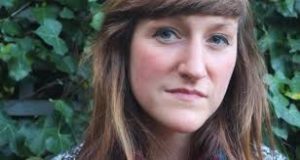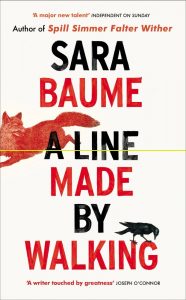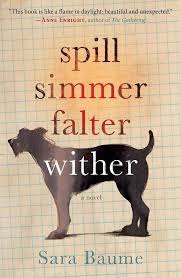Sara Baume: An interview
 Storm Brian is rampaging across Ireland.*
Storm Brian is rampaging across Ireland.*
Works about bad weather, I test myself: Bad Weather Collage, Naomi Vona.¹ A black and white photograph of a man in a suit. There is a blue paper cloud above his head and the head itself is obscured by strips of paper in white, pink and yellow. From the confusion of paper strips radiates a tangle of blue lines, like a minimalist version of Mr Messy. The blue lines connect to a blue disc of paper stuck over the man’s solar plexus.
Unlike Frankie, the protagonist in Sara Baume’s second novel, A Line Made by Walking, I have no idea how to interpret Bad Weather Collage, but it looks like an accurate representation of how I feel when I receive her email informing me that she’s had to pull out of the 2017 Dundee Literary Festival. I had arranged to interview Baume after her event, but with floodwater pouring out of the fields and into the roads around her home near Skibbereen, she doesn’t think she can get to the airport in Cork and even if she can get there, she thinks her flight might be cancelled. She’s sorry for letting me down. The tone of her email is warm; her apology sincere. I’m disappointed but I understand; the weather is beyond anyone’s control.
I suggest a Skype interview. She comes right back, apologising again. She had intended to suggest it, or actually not a Skype interview because she can’t do Skype, but a “good old- fashioned phone call.” I recollect something she said in a recent interview with the Times Literary Supplement about not being a lover of technology so the phone call option doesn’t surprise me. She thoughtfully checks that I will be able to record it and we schedule an appointment.
Three days later, “Brian” has stormed off and services have been restored. The telephone line whispers a hollow gush and hiss, as if I have a seashell to my ear, but it’s clear enough. Sara Baume is immediately friendly, her speech frequently punctuated with a low chuckle and as we exchange our initial pleasantries, I know that we are going to get on well. I try not to sound inept as I tinker with the sound levels on the recorder but she is understanding. She’s had to conduct the “odd interview” herself and confesses to misgivings about recording equipment – she laughs at the memory: “Oh no! I have to deal with some kind of apparatus.”
Baume was to have shared the stage at Literary Dundee with Mark O’Connell, discussing her second  novel, A Line Made by Walking, alongside his non-fiction book, To be a Machine. It seems appropriate, therefore, to begin with a discussion about technology. What are her thoughts?
novel, A Line Made by Walking, alongside his non-fiction book, To be a Machine. It seems appropriate, therefore, to begin with a discussion about technology. What are her thoughts?
She laughs and confesses to being a little out of step with the modern world: “I feel kind of between generations because I was born in 1984, so technically I fall into the millennial category but I don’t feel like a millennial – I don’t have the same addiction. I grew up without the internet.” She feels that in some respects technology is leaving her behind; for example, she doesn’t have an app on her phone for checking in at the airport. “Everyone else is walking through the gates with their phones out” while she still uses a paper ticket.
So what did she make of O’Connell’s book? “I read the book and was absolutely fascinated by it. He has such a wonderful style.”
For someone without a check-in app on her phone, the transhumanism depicted in O’Connell’s book was always going to be a repellent concept: “I finished that book traumatised. Probably the biggest threat to humanity is that technology will overtake us and the book makes a really convincing case for this.” She hopes that there is something inherent within mankind which will eventually override the insatiable desire to rush forward; a point at which people will reject notions of eternal life and be content to live for their allotted “episode of time.”
Baume is certainly cramming achievements into her own “episode of time.” In 2014 she won the Davy Byrne’s Short Story Award for Solesearcher1, a story about shore angling. Baume’s boyfriend is a keen shore angler and she decided to put her acquired knowledge to good use: “He still gets mileage out of the fact that I won that prize, so I can never complain about fishing ever again.”
Her 2015 debut novel, Spill, Simmer, Falter, Wither won The Sunday Independent, Newcomer of the Year, Irish Book Awards 2015 and the Geoffrey Faber Memorial Prize. Her second novel, A Line Made by Walking, has been shortlisted for the prestigious Goldsmith’s Prize.
It might sound like a charmed trajectory, but Baume has had her share of setbacks. Initially studying a Fine Art degree at Dun Laoghaire College of Art and Design, she became disillusioned and depressed about her lack of artistic achievement, discovered a talent for writing and pursued a master’s degree in Creative Writing at Trinity College, Dublin.
I’m interested in her experience of being both artist and writer; how the two disciplines impact on one another. She tells me that having felt like an imposter in the writing world because of her background in art, she now feels like an imposter in the art world because she’s known as a writer – “So it’s imposter syndrome in whatever I do.” In terms of impact, she thinks studying sculpture has influenced her approach to writing the most:
I address a novel as if it were an art project as opposed to a piece of writing. I didn’t so much with the first novel to be honest: with Spill, Simmer I desperately wanted to prove myself to be up there with the regular writers and it’s only with the second one that I felt like I could do what I wanted – that I’d earned the autonomy to do something different – that was where the images went in and the artworks went in. I stopped thinking of it as something that needed a beginning, a middle and an end. A lot of truth went into the second novel as well.
She compares the processes involved in both creating art and creating writing:
Whether it’s a piece of writing or a piece of art, everything I make comes in tiny parts, you know, so if it’s a novel then I’m taking tiny observations or fleeting moments, gestures, feelings, details of the landscape – and I’m putting them together incrementally until they form a story, and with artworks, it’s the same.
On the page those “tiny observations” translate into evocative descriptions. In Spill, Simmer, the grime in “Ray’s” house practically gets under your fingernails. I ask her if she has a technique for creating such perfect descriptions as “aluminium foil with its twinkle and gash” or the nose of a drunken hitchhiker “scribbled with thread veins like craquelure on a masterpiece”. She surprises me by saying she has “no imagination”; that she has to see things for real and then it’s a matter of finding the right words. Mostly this happens when she’s away from the desk:
I have a post-it pad on my desk and I come to it at various times throughout the day and I put down a word or two… at the moment it says “wind-burned grass” and “white calf”. “White calf” is nothing much, but it’s something I saw as I was walking and there was something striking about it. It was a really dim, misty day… that’s the process of writing for me in a way; remembering what I meant at that moment.
The writing process begins on paper and then moves to the computer:
But at various stages, I print and hold it because by printing something off and reading it again, it sounds different, looks different, feels different.” When she was doing her master’s degree, Baume was writing constantly because she had to, but it’s not the way she likes to work. Currently she’s working on an art project, so she limits her desk time to three or four hours a day. After that, “I can’t look at the screen anymore.
 We talk about her journey to publication; her surprise at being signed for a two-book deal with Tramp Press in Dublin: “I didn’t have an agent or anything in the beginning – I didn’t dream that anyone would be interested in [Spill, Simmer, Falter, Wither] this odd little book about a man and a dog.” Baume says that, in some ways, A Line Made by Walking feels like a first novel – perhaps, because of the semi-autobiographical element and because the bones of it were written before Spill, Simmer.
We talk about her journey to publication; her surprise at being signed for a two-book deal with Tramp Press in Dublin: “I didn’t have an agent or anything in the beginning – I didn’t dream that anyone would be interested in [Spill, Simmer, Falter, Wither] this odd little book about a man and a dog.” Baume says that, in some ways, A Line Made by Walking feels like a first novel – perhaps, because of the semi-autobiographical element and because the bones of it were written before Spill, Simmer.
Although the format of the novels is different, Baume admits that both were “driven by the same sort of despair.” Spill, Simmer is narrated by “Ray”, a lonely outsider, who adopts a one-eyed rescue dog to keep down the rats in his house, revealing only by degrees the real darkness of his past. A Line Made by Walking is also a first-person narrative told from the point of view of “Frankie”, a disillusioned art graduate, who sets herself apart from the world both physically, through isolating herself in her grandmother’s empty cottage, and mentally: “The world is wrong. It took me twenty-five years to realise and now I don’t think I can bear it anymore. The world is wrong and I am too small to fix it; too self-absorbed.”
I wonder if all writers become fixated on a single idea or obsession. Spontaneously, Baume raises the same observation: “I thought it [A Line Made by Walking] was really different and now, standing back I see that it’s kind of a version of the first book.”
I tell her about an interview Colm Toibìn had given to Alan Yentob for the BBC arts programme, Imagine. Toibìn had said he thought most writers write about the same thing over and over again and Baume is quietly amused. She says she has a vision for her third novel “and the vision is kind of the same as the other two and I thought: “Well, that’s okay. Every novel should be a slightly better version of the last novel.’”
She tells me she’s been reading Gwendoline Riley, also on the Goldsmith’s Prize shortlist: “Her most recent novel, First Love, is brilliant but again, all of her novels are really the same novel, re-written slightly better.” Baume likes the idea that a writer, like an artist, will re-visit the same themes, creating a body of work and continually trying to make it better: “Why feel under pressure to create work that you’re completely uncomfortable with just to prove your versatility as a writer?” The revelation that it’s okay to revisit the same themes has “liberated” her.
I refer Baume to the epigram at the front of A Line Made by Walking. It’s a quote from a J.D Salinger story, De Daumier-Smith’s Blue Period, “The worst that being an artist could do to you would be that it would make you slightly unhappy, constantly.” Is she ever happy with her writing? Baume responds with:
No one has ever asked me why I chose it, but it totally captures that feeling; artists never feel totally satisfied with what they’ve made and that’s what keeps you going and again, like Tobìn says, you’re just trying to make the same thing better all the time.
Salinger’s story is about an artist who fakes his credentials to work with a Japanese couple who run correspondence courses in art. It’s a story about spiritual emptiness. At the end of the story, De Daumier-Smith has an epiphany which parallels Frankie’s moment of self-enlightenment: “Salinger in general – his sense of disillusionment – was someone who was very important to me when I was about Frankie’s age, so it seemed to be the right quote to put in.”
A Line Made by Walking grew out of a non-fiction essay about a summer Baume spent in her grandmother’s bungalow:
I was just over twenty-five and felt I’d failed at everything in life – re-writing it at thirty-one/thirty-two, there were so many times I was rolling my eyes at Frankie and wanted to update what she was saying. It wasn’t a reflection of me anymore and I had to stop myself doing that because that was Frankie’s version of me at twenty-five.
On her own admission, the twenty-five-year-old Baume had set her bar extremely high:
I had these very high expectations of my future which never materialised. I talk about Walt Disney in the book and how we grew up in a very American ethos – ‘you can follow your dreams and achieve anything.’ That’s not true. We hear about kids being given prizes at sports day for losing. How are they going to cope with life later on?
Baume betrays a lingering insecurity about her own success as she goes on; “You’re never on any safe career path. A novel that did well might be followed by a novel that does shit, so you’re back to scratch. It’s never plain sailing.”
I suspect that she has nothing to worry about, but she is worried; or, perhaps, nervous, about the forthcoming reading event she has for the Goldsmith’s Prize. I ask her if prizes are important: “I’ve been really lucky and I think they’re wonderful but I’m also really aware of the fact that there are many brilliant books out there which have never won a prize. I have no expectations of winning – the Goldsmith’s in particular – but making the shortlist is like winning to me. It means as much.”
Baume has come a long way in the literary world. Who are her strongest influences, aside from Salinger? She cites Rings of Saturn by W. G. Sebald as being particularly important, and The God of Small Things by Arundhati Roy. Nicola Barker’s Wide Open is also up there. Barker is “such an interesting writer; I’m completely honoured to be on the Goldsmith’s Prize shortlist with her.”
Does she have any advice for aspiring writers? Baume’s advice is to “keep going. It’s right time, right place as much as it is talent. There are a lot of good writers out there, a lot of good books; they have to find the right people at the right time.”
We’ve been talking for over an hour and I’ve almost forgotten my ingenious work-around to glean some descriptive material to compensate for having to do this interview over the telephone. I ask Baume if she can describe the view outside her window and she laughs, roundly:
That’s hilarious because I’m in the window because of shit reception! So, I’m looking out over a misty field and honestly it could be the middle of the night because it’s so dark, because of the mist – there’s a wall and the sea is out there on a clear day, but not today.
¹ Bad Weather Collage, Naomi Vona, Saatchi Art.
* This interview was conducted in October 2017.

Leave a Reply